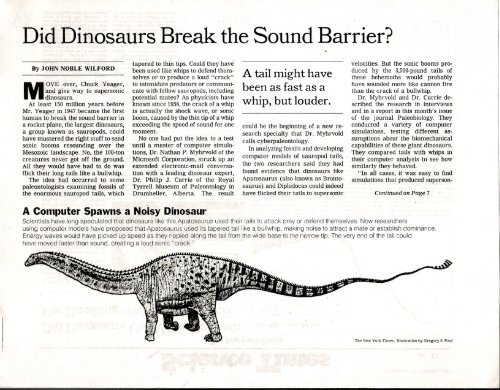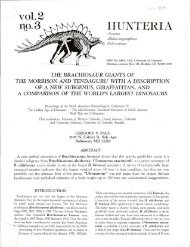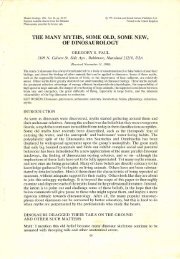Did Dinosaurs Break the Sound Barrier? - Gregory S. Paul
Did Dinosaurs Break the Sound Barrier? - Gregory S. Paul
Did Dinosaurs Break the Sound Barrier? - Gregory S. Paul
Create successful ePaper yourself
Turn your PDF publications into a flip-book with our unique Google optimized e-Paper software.
. . .<br />
<strong>Did</strong> <strong>Dinosaurs</strong> <strong>Break</strong> <strong>the</strong> <strong>Sound</strong> <strong>Barrier</strong>?<br />
By JOHN NOBLE WILFORD<br />
MOVE over,<br />
Chuck 'Yeager,<br />
and give way to supersonic<br />
dinosaurs.<br />
At least 150 million years before<br />
Mr. Yeager in 1947became <strong>the</strong> first<br />
human to break <strong>the</strong> sound barrier in<br />
a rocket plane, <strong>the</strong> largest dinosaurs,<br />
a group known as sauropods, could<br />
have mustered <strong>the</strong> right stuff to send<br />
sonic booms resounding over <strong>the</strong><br />
Mesozoic landscape. No, <strong>the</strong> 100-ton<br />
creatures never got off <strong>the</strong> ground.<br />
All <strong>the</strong>y would have had to do was<br />
flick <strong>the</strong>ir long tails like a bullwhip.<br />
The idea had occurred to some<br />
paleontologists examining fossils of<br />
<strong>the</strong> enormous sauropod tails, which<br />
tapered to thin tips. Could <strong>the</strong>y have<br />
been used like whips to defend <strong>the</strong>mselves<br />
or to produce a loud "crack"<br />
to intimidate predators or communicate<br />
with fellow sauropods, including<br />
potential mates? As physicists have<br />
known since 1958,<strong>the</strong> crack of a whip<br />
is actually <strong>the</strong> shock wave, or sonic<br />
boom, caused by <strong>the</strong> thin tip of a whip<br />
exceeding <strong>the</strong> speed of sound for one<br />
moment..<br />
No one had put <strong>the</strong> idea to a test<br />
. until a master of computer simulations,<br />
Dr. Nathan P. Myhrvold of <strong>the</strong><br />
, Microsoft Corporation, struck up an<br />
extended electronic-mail conversation<br />
with a leading dinosaur expert,<br />
Dr. Philip J. Currie of <strong>the</strong> Royal<br />
Tyrrell Museum of Paleontology in<br />
Drumheller, Alberta. The result<br />
A tail might have<br />
been as fast as a<br />
whip, but louder.<br />
could be <strong>the</strong> beginning of a new research<br />
specialty that Dr. Myhrvold<br />
calls cyberpaleontology.<br />
In analyzing fossils and developing<br />
computer models of sauropod tails,<br />
<strong>the</strong> two researchers said <strong>the</strong>y had<br />
found evidence that dinosaurs like<br />
Apatosaurus (also known as Brontosaurus)<br />
and Diplodocus could indeed<br />
•<br />
velocities. But <strong>the</strong> sonic booms produced<br />
by <strong>the</strong> 3,500-pound tails of<br />
<strong>the</strong>se behemoths would probably<br />
have sounded more like cannon fire<br />
than <strong>the</strong> crack of a bullwhip.<br />
Dr. Myhrvold and Dr. Currie described<br />
<strong>the</strong> research in interviews<br />
and in a report in this month's issue<br />
of <strong>the</strong> journal Paleobiology. They<br />
conducted a variety of computer<br />
simulations, testing different assumptions<br />
about <strong>the</strong> biomechanical<br />
capabilities of <strong>the</strong>se giant dinosaurs .<br />
They compared tails with whips in<br />
<strong>the</strong>ir computer analysis to see how<br />
similarly <strong>the</strong>y behaved.<br />
"In all cases, it was easy to find<br />
simulations that produced superson-<br />
have flicked <strong>the</strong>ir tails to supersonic Continued on Page 7<br />
A Computer Spawns a Noisy Dinosaur<br />
Scientists have long speculated that dinosaurs like this Apatosaurus used <strong>the</strong>ir tails to attack prey or defend <strong>the</strong>mselves. Now researchers<br />
using computer models have proposed that Apatosaurus used its tapered tail like a bullwhip, making noise to attract a mate or establish dominance.<br />
Energy waves would have picked up speed as <strong>the</strong>y rippled along <strong>the</strong> tail from <strong>the</strong> wide base to <strong>the</strong> narrow tip. The very end of <strong>the</strong> tail could<br />
have moved faster than sound, creating a loud sonic "crack."<br />
The New York Times; Illustration by <strong>Gregory</strong> S. <strong>Paul</strong>
Science Times<br />
. .mbtNt\tJ !l!ork mimes<br />
<strong>Did</strong> <strong>Dinosaurs</strong> UseWhiplike Tails r-T-h--'e=--·~i-no-s-au-r -Sw-in-g--"-------'--------------,<br />
For <strong>Break</strong>ing <strong>the</strong> <strong>Sound</strong> <strong>Barrier</strong>?<br />
COlltimH'd From First SCi('t1('C,' PaJ~(~<br />
ic motion," <strong>the</strong> scientists wrote.<br />
"The geometric scaling of vertebral<br />
dimensions found in <strong>the</strong> various. dlplodoctds<br />
strongly suggests that any<br />
of <strong>the</strong>m. or mm-diplndocld sauropods<br />
with ,',&,hiplash' tails, would share<br />
this capability."<br />
With one side-to-side flick, <strong>the</strong> researchers<br />
determined, a wave of energy<br />
could accelerate through <strong>the</strong><br />
length of one of <strong>the</strong> tapering, segmented<br />
tails, gaining momentum to<br />
propel <strong>the</strong> tip of <strong>the</strong> tail to velocities<br />
of more than 750 miles an hour, faster<br />
than <strong>the</strong> speed of sound.<br />
"We must confess that it is pleasing<br />
to think that <strong>the</strong> first residents of<br />
Earth to exceed <strong>the</strong> sound barrier<br />
were not humans, but ra<strong>the</strong>r <strong>the</strong> diplodocid<br />
sauropods," Dr. Myhrvold<br />
and Dr. Currie concluded.<br />
O<strong>the</strong>r dinosuar experts are sharply<br />
divided over. <strong>the</strong>research. <strong>Gregory</strong><br />
S. <strong>Paul</strong>, .~nindependent specialist<br />
in dinosaur anatomy who Is based in<br />
Baltlmnre.. said- he thought <strong>the</strong> concept<br />
of sauropods with supersonic<br />
tails was physically plausible. But at<br />
a recent paleontology conference, he<br />
said, he heard "o<strong>the</strong>r people who just<br />
The possible<br />
explanations for<br />
tail cracking range<br />
from love to war.<br />
hate <strong>the</strong> idea."<br />
,One critic is Dr. Kenneth Carpenter,<br />
a paleontologist at <strong>the</strong> Denver<br />
Museum of Natural History. "To be<br />
blunt," he said in an interview, "<strong>the</strong><br />
computer simulations are ano<strong>the</strong>r<br />
case of garbage in, garbage out."<br />
Dr. Carpenter questioned whe<strong>the</strong>r<br />
<strong>the</strong> bony segments of <strong>the</strong> dinosaur<br />
tails could have produced a superson<br />
ice boom. Even if that was possible,<br />
he said, using <strong>the</strong> taillike a whip<br />
might have been both painful and<br />
damaging to dinosaurs: The last few<br />
segments might even snap off.<br />
In <strong>the</strong>ir report, Dr. Myhrvold and,<br />
Dr. Currie emphasized that only <strong>the</strong><br />
last two or three inches of <strong>the</strong> dinosaur<br />
tail would have exceeded <strong>the</strong><br />
speed of sound. The possibility of<br />
pain or damage might be minimized<br />
Prances Roberts for The New York Times<br />
Dr. Nathan P. Myhrvold of <strong>the</strong> Microsoft Corporation, who creates<br />
computer models of dinosaurs, caUs his work cyberpaleontology,<br />
or eliminated, <strong>the</strong>y pointed out, if <strong>the</strong><br />
most extreme part of <strong>the</strong> tail extended<br />
past <strong>the</strong> last vertebra as a piece, of<br />
skin. tendon or keratin, <strong>the</strong> protein<br />
that can take <strong>the</strong> form of scales,<br />
claws or fea<strong>the</strong>rs. "If whips made<br />
from <strong>the</strong> skins. of cows and kangaroos<br />
are able to withstand supersonic<br />
motion," <strong>the</strong>y said, "'why not dinosaur<br />
skin and tendons?"<br />
But <strong>the</strong> two researchers agreed<br />
with <strong>the</strong> patecnmtogtsts who now reo<br />
jeer <strong>the</strong> idea that <strong>the</strong> sauropods regularly<br />
used <strong>the</strong>ir tails defensively.<br />
The animals would probably have<br />
sustained as much Injury to <strong>the</strong>ir<br />
tails as <strong>the</strong>y inflicted on attackers.<br />
As chief technology offlcer nt M icroson,<br />
Dr. Myhrvold presumably<br />
has mere pressing research matters<br />
than dinosaur tails. But dinosaurs<br />
have fascinated him since childhood,<br />
and he has probably' never' met a<br />
research problem he did not try to<br />
use a computer to solve. He got in <strong>the</strong><br />
habit of stretching <strong>the</strong> imagination<br />
when he studied cosmology under<br />
Dr. Stephen W. Hawking at Cambridge<br />
University in England.<br />
"I don't claim it's relevant to Microsoft,"<br />
he said of <strong>the</strong> dinosaur simulations.<br />
"It's just an int.eresting<br />
problem to me."<br />
'In. particular. Dr. Myhrvold wag<br />
intrigued.by <strong>the</strong> analogy of <strong>the</strong> bullwhip<br />
to explain <strong>the</strong> sauropod tails, as<br />
suggested a few years ago by Dr.<br />
R. McNeill Alexander of <strong>the</strong> University<br />
of Leeds in England. The progressive<br />
rate of tapering from, <strong>the</strong><br />
base of <strong>the</strong> tail to <strong>the</strong> tip is comparahie<br />
to that of a bullwhip from <strong>the</strong> grip<br />
to <strong>the</strong> tip. Each successive vertebra<br />
in a sauropod tail is about 6 percent<br />
smaller than its predecessor.<br />
An analysis of fossils, especially<br />
those of an apatosaur at <strong>the</strong> Carnegie<br />
Museum of Natural History in Pittsburgh,<br />
showed that in {l-fnot tails of<br />
80 vertebrae, <strong>the</strong> lengths of each<br />
connecting segment reached 11 maximum<br />
of some 4 inches in <strong>the</strong> sccuon<br />
between <strong>the</strong> IHIIl and 2~lh vent-brae.<br />
A lop view shows that <strong>the</strong> Apatosaurus lairs base. segmenls<br />
t !tHough 17. was slill and muscular and mi~lhl have<br />
lunclioned like a bullwhip handle.<br />
In soqrnents 18 throuqh 25. R transition mea. vertebrae<br />
are slighlly tonqcr than those at tho tail's base or and.<br />
Thouo vl':.!rluh"H~ nhow sj~Jns of mechanical stress Ih:11<br />
c()tilc.l Il:JVe I){)orl, C(ltl~';()(JI ly ;1 wl1irlpin9 action.<br />
The linal lail seqments were Ilexible, like a<br />
whiplash, in movements parallel 10 <strong>the</strong> ground.<br />
The lip could cover n moter-lonq arc.<br />
Segment 25<br />
Segment 18









